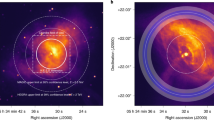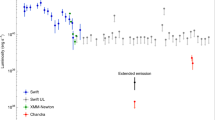Abstract
RECENT radio observations of the Crab Nebula1–3 have demonstrated the existence of a component of small angular diameter which contributes a significant fraction of the total flux density at frequencies of less than about 100 Mc/s. The high brightness temperature deduced from the interplanetary scintillation of this source at 38 Mc/s (ref. 3) makes it difficult to attribute this radiation to the synchrotron process, and coherent radio emission from a dense plasma associated with the star has been suggested as a possible mechanism. The previously reported position for the small diameter source based on a lunar occultation observed at 26.5 Mc/s (ref. 2) lies about 1.2′ arc from the centre of the nebula, however, and is well removed from the centre of the observed expansion. The present observations show that the position of this source in the nebula must be much nearer the centre than the earlier measurement suggests.
This is a preview of subscription content, access via your institution
Access options
Subscribe to this journal
Receive 51 print issues and online access
$199.00 per year
only $3.90 per issue
Buy this article
- Purchase on Springer Link
- Instant access to full article PDF
Prices may be subject to local taxes which are calculated during checkout
Similar content being viewed by others
References
Hewish, A., and Okoye, S. E., Nature, 203, 171 (1964).
Andrew, B. H., Branson, N. J. B. A., and Wills, D., Nature, 203, 171 (1964).
Hewish, A., and Okoye, S. E., Nature, 207, 59 (1965)
Ryle, M., J. Inst. Elec. Eng., 6, 14 (1960).
Crowther, J. H., and Clarke, R. W., Mon. Not. Roy. Astro. Soc., 132, 405 (1966).
Artyukh, V. S., Vitkevitch, V. V., Vlasov, G. A., Kafarov, G. A., and Matveenko, L. I., Soviet Astro., 10, 9 (1966)
Gotwols, B. L., Erikson, W. C., Fremouw, E., and Owren, L., Publ. Astro. Soc. Pacific, 78, 199 (1966).
Baade, W., Astrophys. J., 96, 188 (1942).
Minkowski, R., Astrophys. J., 96, 199 (1942).
Shklovsky, I. S., Soviet Astro., 10, 6 (1966)
Bowyer, S., Byram, E. T., Chubb, T. A., and Friedman, H., Nature, 201, 1307 (1964).
Bowyer, S., Byram, E. T., Chubb, T. A., and Friedman, H., Science, 146, 912 (1964).
Woltjer, L., Bull. Astro. Netherlands, 13, 301 (1957).
Author information
Authors and Affiliations
Rights and permissions
About this article
Cite this article
GOWER, J. Position of the Low Frequency Radio Source in the Crab Nebula. Nature 213, 1213–1214 (1967). https://doi.org/10.1038/2131213a0
Received:
Issue Date:
DOI: https://doi.org/10.1038/2131213a0
This article is cited by
-
The crab nebula
Astrophysics and Space Science (1973)
-
Low-frequency Spectrum of the Crab Nebula
Nature (1970)
-
Coherent Synchrotron Emission in the Crab Nebula
Nature (1970)
-
Discovery of Optical Signals from Pulsar NP 0532
Nature (1969)
-
Acceleration of ultrarelativistic electrons in the Crab Nebula
Astrophysics and Space Science (1969)
Comments
By submitting a comment you agree to abide by our Terms and Community Guidelines. If you find something abusive or that does not comply with our terms or guidelines please flag it as inappropriate.



